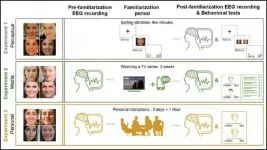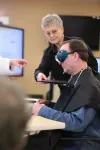(Press-News.org) Has your heart ever started to race at the thought of an upcoming deadline for work? Or has the sight of an unknown object in a dark room made you jump? Well, you can probably thank your amygdala for that.
The small almond-shaped brain structure is central to how we perceive and process fear. As we start to learn to associate fear with cues in our environment, neuronal connections within the amygdala are dynamically altered in a process called synaptic plasticity. Although this physiological mechanism is important for facilitating fear learning, it has mostly been studied in the context of excitatory neurons within the amygdala. Far less is known about the role inhibitory cells play.
In a recent publication in Cell Reports, MPFI scientists from the Bolton Lab delve deeper into a specialized portion of inhibitory circuitry in the amygdala, known as the apical intercalated cell cluster (apITC). Characterizing this small but distinctive cluster of cells, the Bolton Lab has discovered rich connectivity and a rather unique ability to modulate plasticity in the amygdala.
"What really grabbed our attention was the fact that relatively little was known about apITC function or connective circuitry," explains Douglas Asede, Ph.D., first author and former postdoc in the Bolton Lab. "When working with a relatively unknown brain area, it's a game of inputs and outputs. First, you have to identify what connects with the neuron cluster and what it connects to, then evaluate what functional role that circuitry plays."
The Bolton Lab began its investigation by characterizing and functionally testing the incoming connections to the apITC. First, the team utilized a highly specialized technique called monosynaptic tracing to selectively identify the upstream presynaptic partners. Once identified, the researchers used a combination of presynaptic optogenetic stimulation (light activation) and postsynaptic electrophysiology to verify that the connections were functional.
"We were able to unravel a number of diverse inputs for this unique cell cluster, ranging from areas important for memory such as the entorhinal cortex to sensory processing regions such as the thalamus," explains Dr. Asede. "Among this diversity, two notable inputs from the thalamus stood out because of their relative strength compared to other connections we tested as well as their origin in thalamic regions known for their involvement in fear learning."
The strong connections to the apITC originated from two areas of the thalamus, the medial geniculate nucleus (MGm) and the posterior intralaminar nucleus (PIN). Previous work has shown the MGm and PIN to be important processing centers for auditory and somatosensory information, respectively. In the context of fear learning, inputs from the thalamus send fear-related sensory information to the amygdala, which then integrates and associates fear with particular cues from the environment.
To examine whether this sensory information flow through the apITC was important for fear learning, MPFI scientists studied the changes in these synaptic connections in mice directly after behavioral training. A group of mice underwent classical fear conditioning and behavior-driven changes and were then evaluated using pre and post-synaptic markers for plasticity. Interestingly, the team found significant signs of synaptic strengthening in the sensory inputs to the apITC after fear learning when compared to control animals.
"Typically, when synapses are important to a particular behavior, their connections are strengthened during learning, so our results really highlighted the importance of these sensory connections in fear learning," notes Dr. Asede.
The LA is a region of the amygdala that is strongly associated with fear learning, fear-related sensory integration, and the formation of fear-based memories. The Bolton Lab used simultaneous electrical stimulation of thalamic sensory inputs and optogenetic stimulation of apITC cell inputs to the LA to reveal that activation of apITC acts as a gate to reduce incoming sensory-driven responses in the LA.
"Armed with the understanding that apITC is important for sensory gating and fear learning, we next looked at what type of downstream connections the apITC makes to give us a clue about possible functions the cluster has in the amygdala fear circuitry."
Classically it's been thought that inhibitory cells within the brain make very short-range, downstream connections, acting to dynamically modify circuits within their own local environments. Using axonal reconstruction, the Bolton Lab identified that while most apITC connections are local axon collaterals to neighboring apITCs or project to a close region within the amygdala called the lateral amygdala (LA). Surprisingly, they also identified a subset of relatively long-range connections to more distant brain structures, challenging classical thinking on inhibitory circuits.
"The apITC is one of several clusters of inhibitory neurons that surround the amygdala like a
net. Each cluster has a unique role in regulating emotional processing in the amygdala by gating specific inputs," notes Mclean Bolton, Ph.D. and Research Group Leader at MPFI. "The ITCs have receptors for many neuromodulators such as dopamine, opiates, and oxytocin so they may function as a barometer for sensing internal state and modifying emotions accordingly. This makes them a potential target for therapies to treat anxiety and PTSD, so understanding how each cluster contributes to amygdala function is important."
INFORMATION:
CHICAGO, May 24, 2021--More than a year after COVID-19 appeared in the U.S., dentists continue to have a lower infection rate than other front-line health professionals, such as nurses and physicians, according to a study published online ahead of the June print issue in the Journal of the American Dental Association. The study, "COVID19 among Dentists in the U.S. and Associated Infection Control: a six-month longitudinal study," is based on data collected June 9 - Nov. 13, 2020.
According to the study, based on the number of dentists with confirmed or probable COVID-19 infections over more than six months, the cumulative infection rate for U.S. dentists is 2.6%. The monthly incidence ...
Researchers at Lund University in Sweden have developed an algorithm that combines data from a simple blood test and brief memory tests, to predict with great accuracy who will develop Alzheimer's disease in the future. The findings are published in Nature Medicine.
Approximately 20-30% of patients with Alzheimer's disease are wrongly diagnosed within specialist healthcare, and diagnostic work-up is even more difficult in primary care. Accuracy can be significantly improved by measuring the proteins tau and beta-amyloid via a spinal fluid sample, or PET scan. However, those methods are expensive and only available at a relatively few specialized memory clinics worldwide. Early and accurate ...
Ecology, the field of biology devoted to the study of organisms and their natural environments, needs to account for the historical legacy of colonialism that has shaped people and the natural world, researchers argued in a new perspective in the journal Nature Ecology & Evolution.
To make ecology more inclusive of the world's diverse people and cultures living in diverse ecosystems, researchers from University of Cape Town, North West University in South Africa and North Carolina State University proposed five strategies to untangle the impacts of colonialism on research and thinking in the field today.
"There are significant biases in our understanding ...
The neural representation of a familiar face strengthens faster when you see someone in person, according to a new study published in JNeurosci.
The brain loves faces -- there's even an interconnected network of brain areas dedicated to face-processing. Despite all the research on how the brain sees faces, little is known about how the neural representation of a face changes as it becomes familiar.
To track how familiarity brain signals change, Ambrus et al. measured participants' brain activity with EEG before and after getting to know different ...
A strange phenomenon happens with modern blue whales, humpback whales and gray whales: they have teeth in the womb but are born toothless. Replacing the teeth is baleen, a series of plates composed of thin, hair- and fingernail-like structures growing from the roof of their mouths that act as a sieve for filter feeding small fish and tiny shrimp-like krill.
The disappearing embryonic teeth are testament to an evolutionary history from ancient whales that had teeth and consumed larger prey. Modern baleen whales on the other hand use their fringed baleen to strain their miniscule prey from water, hence the term filter feeding.
A new study that utilized high-resolution computed tomography (CT) to ...
East Hanover, NJ. May 24, 2021. A recent qualitative study of rehabilitation professionals caring for people with spatial neglect enabled researchers to identify interventions to improve rehabilitation outcomes. Experts reported that implementation of spatial neglect care depends on interventions involving family support and training, promotion of interdisciplinary collaboration, development of interprofessional vocabulary, and continuous treatment and follow-up assessment through care transitions.
The article, "Barriers and Facilitators to Rehabilitation Care of Individuals with Spatial ...
Scientists at the University of York have made significant progress in the development of a nasal spray treatment for patients with Parkinson's disease.
Researchers have developed a new gel that can adhere to tissue inside the nose alongside the drug levodopa, helping deliver treatment directly to the brain.
Levodopa is converted to dopamine in the brain, which makes-up for the deficit of dopamine-producing cells in Parkinson's patients, and helps treat the symptoms of the disease. Over extended periods of time, however, levodopa becomes less effective, and increased doses are needed.
Professor David Smith, from the ...
Extra funding should be made available for early years care in the wake of the pandemic, researchers say.
Experts at the University of Leeds, University of Oxford and Oxford Brookes University have made the call after assessing the benefits of early childhood education and care (ECEC) for children under three during COVID-19.
They found children who attended childcare outside the home throughout the first UK lockdown made greater gains in language and thinking skills, particularly if they were from less advantaged backgrounds.
And now they are making several policy recommendations ...
Research Study Key Takeaways:
Ridesharing can reduce a passenger's risk of being a target of sexual assault by providing a more reliable and timely transportation option for traveling to a safer place.
The entry of Uber into a city contributes to a 6.3% reduction in rape incidents.
A 1% increase in Uber pickups in a neighborhood translates to a more than 3% decrease in the likelihood of sexual assaults.
CATONSVILLE, MD, May 24, 2021 - Contrary to portraits painted in popular media, new research involving ridesharing services shows they provide an additional level of protection for potential sexual assault victims, particularly ...
Regular physical activity has positive effects on children's developing brain circuits, finds a Boston Children's Hospital study using neuroimaging data from nearly 6,000 early adolescents. Physical activity of any kind was associated with more efficiently organized, flexible, and robust brain networks, the researchers found. The more physical activity, the more "fit" the brain.
Findings were published in Cerebral Cortex on May 14.
"It didn't matter what kind of physical activity children were involved in - it only mattered that they were active," says Caterina Stamoulis, PhD, principal ...


